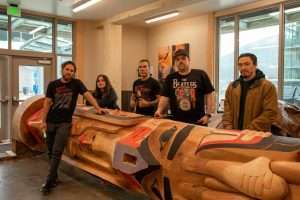Three-Sided Pole Speaks to Community, Collaboration and Kinship

Haida carver TJ Young (Sgwaayaans) is hard at work creating the first 360-degree totem pole to be raised in Alaska. The Sealaska Cultural Values Pole will stand guard over Heritage Square at the center of the new Sealaska Heritage Arts Campus in downtown Juneau. Young is carving the pole with assistance from his brother, Joe Young and guest carvers David R. Boxley, who is Tsimshian, and Rob Mills, who is Tlingit. He also worked with apprentices Greg Frisby and Andrea Cook, who are both Haida, and sees the project as a community undertaking of working together.
“Traditionally, we’ve been so interwoven over the past thousands of years,” said Young. “Haida people, we got our copper from the Tlingits. We got our mountain goat wool from the Tsimshian on the mainland. We literally shared the same stories. We were and we are still all interconnected.”
“Now we even help each other carve totem poles,” Young added, laughing. “Working together is what it is—not divided like oh, this here is Tlingit, this is Haida, this is Tsimshian. It’s a working together relationship. Same goes for our carving.”
While the collective labor going into this project is not uncommon, the type of project — a 360-degree carved totem pole — is unique. The three-sided pole isn’t just a novelty. It calls back to the three groups of Indigenous people — Tlingit, Haida and Tsimshian — that Sealaska represents. The figures depicted throughout are shared across the three cultures: Raven and Eagle, for balance; the man who holds up the world and the strongman ripping apart the sea lion make up the base; a salmon, emphasizing the critical importance of the salmon and its return; the moon and sun, stolen by Raven at the creation of the world; and three watchmen, representing Tlingit, Haida and Tsimshian people.
The connection to each culture goes even deeper with the three watchmen, Young explains. A different carver — one from each of the three cultures — carved each watchman’s face. Young carved the Haida face himself, while Boxley, who also created Sealaska’s new salmon-egg logo, carved the Tsimshian face. Mills carved the Tlingit face.
Many of the figures also share body parts, in another nod to the interdependence and reciprocal nature of Southeast Alaska’s Native community, he said. Reciprocity is also inherent to the project itself, as the log for the pole was donated by Sealaska. Access to cedar logs needed for projects like totem poles and canoes is limited.
The availability of high-quality logs such as the one used for this project is vital to maintaining the integrity of the art of carving, explained Young. Sealaska provides access to monumental cultural logs for carvers like Young and projects like the new totem trail being created in downtown Juneau by SHI. Applicants should contact Michele Metz at michele.metz@sealaska.com for more information on the log donation process.
After nearly eight months of carving, the project is set to be complete by late April, with the totem dedication expected to take place at the same time as the dedication of SHI’s new Heritage Square project in downtown Juneau, adjacent to Sealaska’s corporate headquarters. These events are planned to occur during SHI’s Celebration event June 7-11, although a specific date and time has not yet been announced.
Photos below courtesy of Sealaska shareholder Connor Meyer.










 Previous
Previous